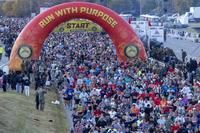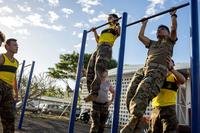It is no wonder people get overwhelmed with starting or continuing with the habit of fitness and physical activity. If you think about the pure volume and options that are available, there are so many. Some may truly interest you, but on the other hand, the sheer volume of choices can be equally intimidating.
So consider going for 3-4 weeks or a month, which could be a total of 15 workouts if you do three or four a week and focus on a specific fitness component. If you break down the fitness world into smaller segments, you may find something that interests you while lessening the degree to which you are overwhelmed.
Strength
A foundation of strength will go a long way in your ability to move freely and be less susceptible to injury. Strength training comes in so many styles, it can be somewhat overwhelming. The myth that lifting weights makes you bulky does not help many women seeking to learn how to do resistance training regularly as well.
Strength training can start with calisthenics and isometric holds (i.e., plank pose), then progress into dumbbells, machines and barbells.
Suspension Training
Devices such as the TRX have created a relatively new component of fitness training that can make calisthenics easier or harder, depending on how you diversify your angle of movements. This component is so versatile that those of any fitness level can use it.
Muscular Stamina (Calisthenics/High-Repetition Weights)
Many bodybuilding programs consist of high-volume repetitions and sets targeting certain muscle groups and are a way to train muscle stamina. Calisthenics can start as a strength exercise and evolve into a muscle stamina/endurance exercise as you improve. For instance, a pull-up is a strength exercise for your first repetition. But for your 20th repetition, you have made that exercise one involving muscle stamina.
Cardiovascular Fitness (Aerobic/Anaerobic)
If you are beginning, simply start walking. This one component can get overwhelming quickly as there are so many ways to develop cardiovascular fitness. Go-to-exercise options for many people include the following: walk, jog, sprint, bike, row, elliptical, skate, swim and ruck. There's also tactical training and machine-based cardio options.
Body Composition
This component of fitness focuses on the spectrum from healthy body weight to aesthetic development, such as bodybuilding. A lower fat composition and greater muscular development is a balance of lifting weights, steady cardio and tighter control of calories consumed to lose fat and gain muscle.
Most people tend to begin in fitness with the goal of more muscle and less fat on their bodies. Body composition is also tested throughout the military, with limits on body-fat percentage to be eligible for service.
Flexibility/Mobility
Having flexible muscles and tendons and more range of motion in the joints should be a long-term goal for anyone considering starting a fitness routine. Many people solely practice yoga and develop strength and muscle stamina through stretching and isometric holds to master their own body weight.
This should be part of a warmup or cooldown, even if only for 5-10 minutes each day. The benefits of being less stiff, less susceptible to injury and in less pain can be attributed to adding flexibility and mobility to your day.
Coordination of Movements and Skills/Techniques
This component usually has more to do with competitive athletic training, such as pickleball, tennis and basketball, but it also can apply to movements that require greater technique training (swinging a racket or bat, swimming, climbing, jumping, lifting, rowing, kicking, throwing, etc.).
This component of fitness is fun but requires practice to see improvements during competitions. Usually, the better way to enjoy sports as a fitness event is to prepare the body for the specific demands of that sport through workouts in any of the above components.
Balance/Reaction Time
A person's balance is also critical to health and wellness. The ability to react quickly to changing situations and not lose one’s balance and fall is the ultimate longevity exercise as we age. Use it or lose it. Reaction time can also be developed through the sports above, as hand-eye coordination is key to seeing, reacting and gaining stability quickly.
Agility/Speed/Power
I saved this category for last, as it should be one of the latter options someone considering fitness as a beginner or new to training altogether should try. Building a foundation of strength, durability, flexibility and mobility all will help a person who is adding the speed component to lifting weights, calisthenics or cardio activities as well.
Changing direction quickly is also challenging and considered more advanced movements that require similar foundations of fitness and athletic ability before aggressively training with agility work.
Many of these components go very well together; some can definitely affect progress in others. Understand how these groups together can make your workouts more productive. See the seasonal tactical fitness periodization training model for ways to incorporate these components of fitness in a program for more intermediate/advanced tactical athletes.
However, if you are beginning, consider picking one component and doing it every other day for a month. Then change and pick another option. You will find this regular change to your fitness is helpful with workouts not getting stale, and the diversity in exercise selection is going to help make you more well-rounded physically and able to handle more of what life throws at you.
Stew Smith is a former Navy SEAL and fitness author certified as a Strength and Conditioning Specialist (CSCS) with the National Strength and Conditioning Association. Visit his Fitness eBook store if you're looking to start a workout program to create a healthy lifestyle. Send your fitness questions to stew@stewsmith.com.
Want to Learn More About Military Life?
Whether you're thinking of joining the military, looking for fitness and basic training tips, or keeping up with military life and benefits, Military.com has you covered. Subscribe to Military.com to have military news, updates and resources delivered directly to your inbox.


















